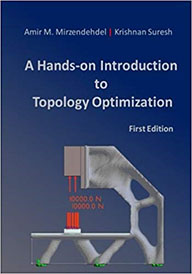Learning Topology Optimization Through Examples and Case Studies
Prof. Krishnan Suresh
Philip and Jean Myers Professor of Mechanical Engineering
University of Wisconsin, Madison
ksuresh@wisc.edu
Overview
The objective of this workshop is to expose the audience to cutting-edge topology optimization techniques. Strategies for posing and solving multi-load, multi-body topology optimization problems will be presented. Recent developments in integrating topology optimization and additive manufacturing will also be discussed. The course content will be based on the following book:

Expected Background of Participants
The primary audience include senior undergraduate students, graduate students, faculty and practicing engineers. Given this wide audience, no prior background in topology optimization is assumed; a working knowledge of finite element analysis (FEA) is however helpful. The primary objectives are to introduce the readers to topology optimization terminology, discuss and illustrate various sensitivity analysis techniques (that form the backbone of any topology optimization method), provide numerous examples and case-studies to illustrate the merits of topology optimization. While Pareto is used in this workshop to illustrate the main concepts, the attendee can later use any topology optimization software that is capable of handling the problems.
Workshop Motivation
Topology optimization (TO) is an exciting method for generating insightful and creative designs. The objective of this workshop is to offer a hands-on introduction to topology optimization, by juxtaposing theory with examples and case-studies. Over the past several years, additive manufacturing (AM) has emerged as a promising alternate to subtractive methods. AM refers to a class of manufacturing processes through which parts are fabricated by material addition. The growing interest in AM stems from its ability to fabricate highly complex parts, with minimal effort. AM and TO complement each other in that organic and complex designs generated through TO can be easily manufactured through AM. Despite the obvious synergy, there are several challenges that need to be addressed before TO and AM can be seamlessly integrated. Some of these will be discussed during the workshop.
Biographical Sketch of Presenter
Krishnan Suresh is the Philip and Jean Myers Professor of Mechanical Engineering at the University of Wisconsin-Madison. He received a Master’s in Manufacturing Engineering from UCLA in 1992, and a Master’s and Ph.D. in Mechanical Engineering from Cornell in 1994 and 1998, respectively. He later served as an Engineering Manager at Kulicke and Soffa Industries, Philadelphia from 1998 to 2002.
He has received numerous peer-reviewed grants, including the prestigious NSF Career award. His research interests include topology optimization, additive manufacturing, advanced finite element analysis and high-performance computing. He has co-authored over 75 peer-reviewed papers, two of which have received best-paper awards from ASME. He has also authored two text-books on applied optimization. He is the founder of SciArt, LLC (www.sciartsoft.com), a UW-Madison spinoff that creates and supports high-performance topology optimization software solutions.
Course Outline
Morning Session
-
Overview of topology optimization
-
Example 1: Posing and solving a simple structural optimization problem
-
Example 2: Restraints and loads
-
Example 3: Stress and displacement constraints
-
Example 4: Design constraints
-
Example 5: Multi-load problems
-
Example 6: Multi-body problems
Afternoon Session
-
Example 7: Design iterations
-
Example 8: Body forces
-
Example 9: Thermo-elastic topology optimization
-
Case study: GE-GrabCAD design optimization
-
Case study: Alcoa-GrabCAD design optimization
-
Design challenge
-
Topology Optimization and AM: Challenges and Opportunities
Workshop Material
The book and power-point slides used during the course will be provided to participants.